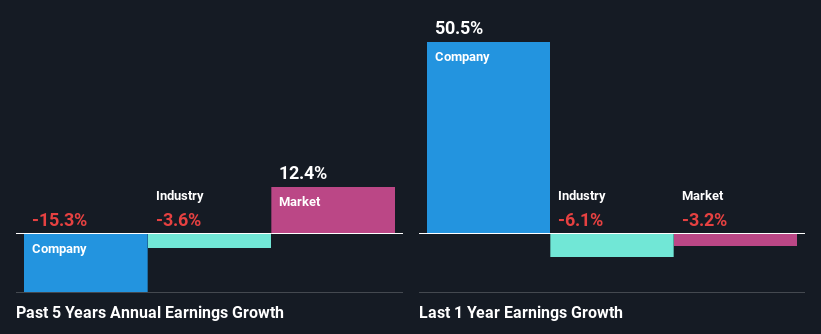- United Kingdom
- /
- Consumer Durables
- /
- LSE:BWY
Bellway p.l.c.'s (LON:BWY) Stock Is Going Strong: Have Financials A Role To Play?
Bellway (LON:BWY) has had a great run on the share market with its stock up by a significant 16% over the last three months. As most would know, fundamentals are what usually guide market price movements over the long-term, so we decided to look at the company's key financial indicators today to determine if they have any role to play in the recent price movement. Particularly, we will be paying attention to Bellway's ROE today.
ROE or return on equity is a useful tool to assess how effectively a company can generate returns on the investment it received from its shareholders. Put another way, it reveals the company's success at turning shareholder investments into profits.
Check out our latest analysis for Bellway
How To Calculate Return On Equity?
ROE can be calculated by using the formula:
Return on Equity = Net Profit (from continuing operations) ÷ Shareholders' Equity
So, based on the above formula, the ROE for Bellway is:
11% = UK£365m ÷ UK£3.5b (Based on the trailing twelve months to July 2023).
The 'return' is the yearly profit. That means that for every £1 worth of shareholders' equity, the company generated £0.11 in profit.
Why Is ROE Important For Earnings Growth?
So far, we've learned that ROE is a measure of a company's profitability. Based on how much of its profits the company chooses to reinvest or "retain", we are then able to evaluate a company's future ability to generate profits. Generally speaking, other things being equal, firms with a high return on equity and profit retention, have a higher growth rate than firms that don’t share these attributes.
Bellway's Earnings Growth And 11% ROE
At first glance, Bellway seems to have a decent ROE. Further, the company's ROE is similar to the industry average of 10%. As you might expect, the 15% net income decline reported by Bellway is a bit of a surprise. We reckon that there could be some other factors at play here that are preventing the company's growth. Such as, the company pays out a huge portion of its earnings as dividends, or is faced with competitive pressures.
Next, when we compared with the industry, which has shrunk its earnings at a rate of 3.6% in the same 5-year period, we still found Bellway's performance to be quite bleak, because the company has been shrinking its earnings faster than the industry.

Earnings growth is a huge factor in stock valuation. It’s important for an investor to know whether the market has priced in the company's expected earnings growth (or decline). By doing so, they will have an idea if the stock is headed into clear blue waters or if swampy waters await. If you're wondering about Bellway's's valuation, check out this gauge of its price-to-earnings ratio, as compared to its industry.
Is Bellway Using Its Retained Earnings Effectively?
Bellway has a high three-year median payout ratio of 50% (that is, it is retaining 50% of its profits). This suggests that the company is paying most of its profits as dividends to its shareholders. This goes some way in explaining why its earnings have been shrinking. The business is only left with a small pool of capital to reinvest - A vicious cycle that doesn't benefit the company in the long-run. To know the 2 risks we have identified for Bellway visit our risks dashboard for free.
Additionally, Bellway has paid dividends over a period of at least ten years, which means that the company's management is determined to pay dividends even if it means little to no earnings growth. Upon studying the latest analysts' consensus data, we found that the company is expected to keep paying out approximately 41% of its profits over the next three years. Still, forecasts suggest that Bellway's future ROE will drop to 7.1% even though the the company's payout ratio is not expected to change by much.
Summary
In total, it does look like Bellway has some positive aspects to its business. Yet, the low earnings growth is a bit concerning, especially given that the company has a high rate of return. Investors could have benefitted from the high ROE, had the company been reinvesting more of its earnings. As discussed earlier, the company is retaining a small portion of its profits. That being so, the latest industry analyst forecasts show that analysts are forecasting a slight improvement in the company's future earnings growth. Sure enough, this could bring some relief to shareholders. To know more about the company's future earnings growth forecasts take a look at this free report on analyst forecasts for the company to find out more.
Valuation is complex, but we're here to simplify it.
Discover if Bellway might be undervalued or overvalued with our detailed analysis, featuring fair value estimates, potential risks, dividends, insider trades, and its financial condition.
Access Free AnalysisHave feedback on this article? Concerned about the content? Get in touch with us directly. Alternatively, email editorial-team (at) simplywallst.com.
This article by Simply Wall St is general in nature. We provide commentary based on historical data and analyst forecasts only using an unbiased methodology and our articles are not intended to be financial advice. It does not constitute a recommendation to buy or sell any stock, and does not take account of your objectives, or your financial situation. We aim to bring you long-term focused analysis driven by fundamental data. Note that our analysis may not factor in the latest price-sensitive company announcements or qualitative material. Simply Wall St has no position in any stocks mentioned.
About LSE:BWY
Excellent balance sheet average dividend payer.
Similar Companies
Market Insights
Community Narratives




